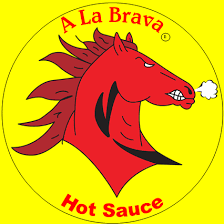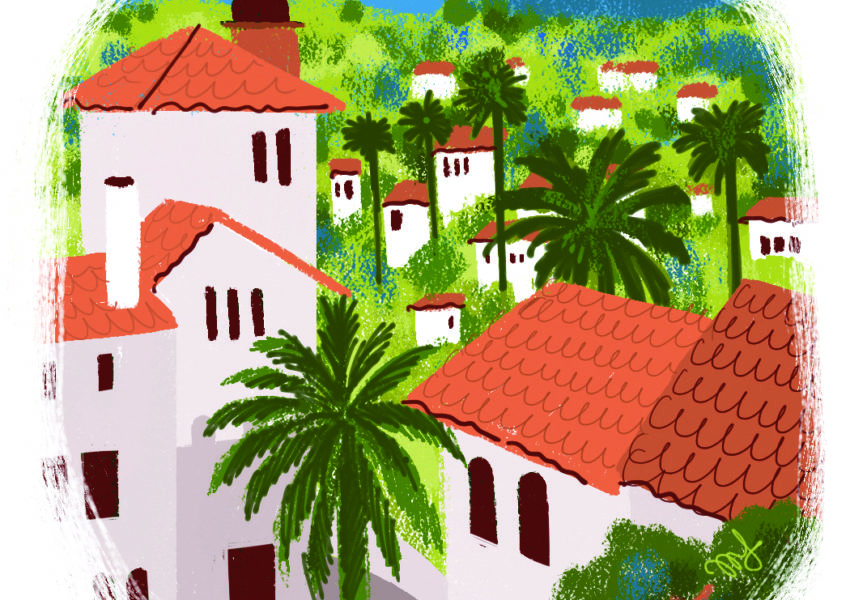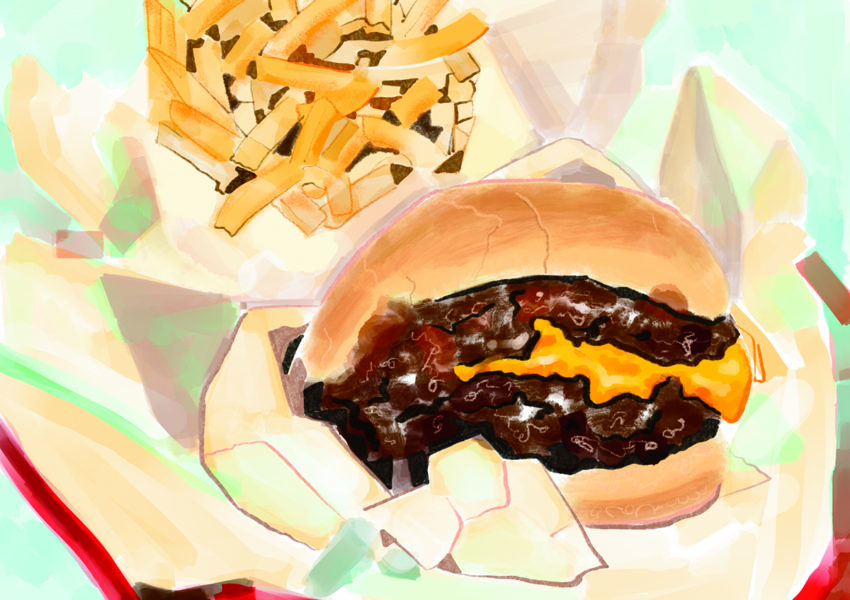Bajito y Despacito From barbacoa to barbecue and back
by Gustavo Arellano
photos by Ethan Payne
A couple of years ago, I went to a party hosted by uno de los de mi Tía María—one of the cousins born to my Tía María, my mom’s oldest sister. There, I ate the greatest barbecue platter of all time.
Cheese-flavored Doritos covered in nacho sauce and topped with pickled jalapeños. Carne asada slathered in a fiery salsa roja. A hot dog smeared with mustard, a dash of ketchup, and more salsa. Pinto beans, Spanish rice, more salsa.
Seven of my Tía María’s children bought homes on the street one over from my parents in Anaheim, California. Every summer for nearly my entire life has been a moveable feast of meat.
We call our weekend house parties a “carne asada.” The term literally means “roasted meat” and specifically refers to grilled beef. It’s also what we call small, informal parties where carne asada might or might not be on the menu. In other words, the term “carne asada” functions a lot like the word “barbecue.”
My family is from the north-central Mexican state of Zacatecas, so our carne asadas almost always had, well, carne asada. But my cousins and uncles also grilled chicken, hamburger patties, kielbasa, brats, and chorizo. They made adobada, which is pork marinated in salsa, then chopped up on a flattop grill. And cebollitas—charred green onions. We served ourselves a little bit of everything. There were French rolls for making tortas and tortillas for tacos.
What we did wasn’t technically barbecue in the Southern sense. We weren’t smoking meats low and slow. If our carnes had a smoky flavor, it was a result of char, not time. So we never called it “barbecue.” But we never called it “barbacoa,” either. That’s a tradition from a different part of Mexico, usually made with lamb.
Growing up, American barbecue and Mexican barbacoa didn’t mean much to me. Southern California had its own barbecue traditions. Most of them had roots in the Southeast and Texas. To our north, there was specifically Californian Santa Maria style. But when I was hungry for meat, I just waited for a family carne asada.
Imagine my surprise in 2018, when I went to a high-school graduation carne asada for the next generation of cousins from los de mi Tía María. On the menu were pulled pork, brisket, ribs, and macaroni and cheese. My cousin Esteban had joined the ranks of Mexican Americans who love Southern barbecue.
Over the past five years, Southern cooking has become an obsession for a growing number of second- and third-generation Mexican Americans in southern California. These pitmasters take pilgrimages to North Carolina, Tennessee, and Texas to visit barbecue joints they’ve found online. Back home, they try to replicate the results. Many have transformed their backyard efforts into pop-ups. Some have even opened wildly popular restaurants, like Moo’s Craft Barbecue and A’s BBQ, both in Los Angeles. What’s strange to me is that there has been no parallel move in southern California to embrace barbacoa, even as more immigrants arrive from the barbacoa belt of southern Mexico.
Pulled pork, brisket, ribs—my cousin Esteban had joined the ranks of Mexican Americans who love Southern barbecue.
Meanwhile, I’ve witnessed a reverse trend in the Southeastern United States, where a new wave of Mexican immigrants is selling barbacoa en penca de maguey—barbacoa wrapped in maguey (agave) leaves. In Mexico, maguey leaves are used for everything from textiles to medicines. And for thousands of years, Mexicans have used them to impart food with an earthy fragrance and flavor. That traditional wrapping also protects the meat as it cooks low and slow. Today, restaurant cooks have to use ovens to pass muster with the local health inspector. But on weekends, families and communities dig their own pits and do real barbacoa—the noun and the verb.
Last summer, I decided to eat my way through this conundrum. Why are Mexican Americans in southern California going Southern, while Mexicans who live in the South double down on their mexicanidad?
My survey began last Fourth of July weekend at my cousin Esteban’s house in Anaheim.
When I arrived, the smell of cherry wood and hickory smoke filled the driveway of the suburban home where Esteban and his wife live. Smoked chicken, pulled pork, tri-tip, and ribs sat on two racks of a Meadow Creek box smoker. Chris Young and Kane Brown’s “Famous Friends” blasted on Sonos.
Was I in Anaheim, or in Nashville?
It was Esteban’s first official pop-up. He and his family wore hats with the name of his burgeoning business: LEGENDS BBQ. “I’m not one,” he said, “but I hope to be.”
Esteban told me he developed a taste for barbecue as a teenager in the late 1990s, when his late dad, my compadre Chinto, took him to Southern-style barbecue restaurants in the Los Angeles area after the two of them worked construction. “It was like pork I had never tasted before,” Esteban said. “The smokiness really was incredible.”
Once he got older, Esteban began to experiment with recipes he’d find online, cooking them on an eighteen-inch Weber Smokey Mountain Cooker. Eventually, he started selling his grub and earned enough money to buy a bigger smoker.
Esteban has never been to the South, but he’d like to. He especially wants to visit Memphis, because he loves dry ribs. They were on the menu the day I hung out with him, and they were excellent.
I asked him why so many second-generation Mexicans in southern California were going all-in on Southern barbecue. “I think we just want to try new things,” he said. “As good as carne asada is, it burns out. You want to get something else down. And now there’s so much television and YouTube and TikTok, you see something and think, ‘Well, why can’t I do it?’”
My next stop was in Nashville for barbacoa.
Before the trip, I asked Julio Hernandez, the Nashville-based tortillero behind Maíz de la Vida, if he knew of any spots I should try. He gave me an address and a date and said, “Caile.” Come on down.
I landed in town around 8:30 on a Thursday night in early August and immediately drove about an hour away to the home of Felix Sánchez, a landscaper. In his backyard, Felix and his brother Josué, a line chef at Nectar Urban Cantina, built a three-by-three-foot brick pit where they host barbacoas every couple of months.
Felix is soft-spoken; Josué is rambunctious. They’re from San Pedro Añañé in the Mixteca region of the southern Mexican state of Oaxaca. The two came to Nashville in 2006. They built the oven with some friends three years ago because they missed the barbacoa from back home. The first time they made their traditional dish, barbacoa de borrego (mutton), they bought a sheep from a local butcher and called their mom on FaceTime for advice on how to properly slaughter the animal.

The brothers continue to do things the traditional way, save for one key point: Back in Mexico, their grandfather taught them to poke a hole in the leg of the sheep and blow into it with a reed to make it easier to skin. Here in Nashville, Felix and Josué use an air compressor.
The night I visited, they were going to barbecue a goat. Their friend, Chepe Laredo, the chef de cuisine for Maíz de la Vida, had marinated the goat overnight in the style of his region of Oaxaca, la Costa Chica. Cooks from this Afro-Mexican community on the Pacific Coast rub their meat with chile puya, cumin, and black pepper, a spicier blend than Mixtecan barbacoa.
We passed around bottles of mezcal while waiting for pine logs to turn into coals. Cumbias and banda played nonstop. We even sang karaoke. It was 10:30 on a weeknight.
I asked Josué if the neighbors ever complained. “They came the first time and asked what we were doing,” he said. “But then we gave them a plate, and they’ve been coming over ever since. You don’t go find friends. Friends come.”
Once the coals were ready, Chepe brought out the goat, which had been marinating in a small tub. He and Josué wrapped maguey leaves around the meat, put foil on top of the tub, then lowered it into the pit with hooks made of rebar.
Josué explained to me that they usually sprinkle a layer of masa under the barbacoa to catch all the drippings. This time, though, they were going to keep the consommé for a second barbacoa the following day.
Everyone grabbed a dried chile de árbol and threw it into the pit to ward off el mal ojo—the evil eye. Everyone except the one white guy, that is. He ate the chile by accident.
Felix, Josué, and Chepe covered the oven with cast-iron slats, then an orange metal traffic sign that read ROAD CLOSED AHEAD. Josué layered on sheets of cardboard that had been soaked so as to not catch fire. Finally, everyone grabbed a shovel and covered the pit with dirt. When we were done, Josué poured mezcal on the mound in the sign of the cross, then placed two crossed shovels on top.
In twelve hours, we’d have brunch.
The following morning, I returned to Felix Sánchez’s house. There were more people now, ready to eat.
“Resucitamos al difunto?” Josué cracked. Shall we raise the dead?

We shoveled off the dirt, removed the cardboard and metal slabs, and lifted the tub. Josué and Chepe unwrapped the maguey leaves. The goat now swam in a sea of ruby-red broth. Josué grabbed a rib. The meat slipped off like water from a faucet.
More mezcal flowed. Who cared if it was only ten in the morning? The barbacoa was so flavorful—soft, spicy, luscious—that it didn’t need salsa. Josué plans to open a food truck and sell this style of barbacoa, along with lamb. I asked if he ever did brisket. “Of course, it’s good,” he replied. “Pero lo nuestro es único.” What’s ours is unique.
A couple of hours later, we all went to a second barbacoa at the house of Robbie Mezanava. He’s a native of Los Angeles, an Army veteran, and a chef. Today, he’d be cooking lechón—suckling pig.
As we waited for the logs to burn down, Robbie built an impromptu brick pit on his patio. This is where his lechón would twirl for two hours.
Robbie moved to Nashville in 2014 and quickly fell in love with Southern barbecue. But for him, practicing Mexican meat traditions in the South is a way for him to maintain his culture rather than be subsumed by the dominant local one. “Open fire was all my parents had back in Mexico,” he said. “Barbecue is like a tribute to our ancestors.”
When I told him that the Mexican Americans of his generation back in California were cooking Southern-style barbecue, Robbie laughed. “Man, my brisket would beat them any day! Do we need to go down to Cali and show them what’s up?”

The lechón was fantastic, but we were still hungry. Bourbon flowed. Someone threw some arrachera—skirt steak—on the grill. Julio brought out some of his tortillas and heated them just underneath the lechón. Barbacoa met carne asada met barbecue.
The following day, I drove up to Bowling Green, Kentucky for my final barbacoa stop. Victor Olivo Sr. and his family sell beef barbacoa from their taco truck in Portland, Tennessee, in the style of San José de la Paz, Jalisco. That’s the city whose expats—a group of people who call themselves los restauranteros—have dominated the Sur-Mex restaurant scene for the past forty years. If you want to roll your eyes at the most infamous dishes of Sur-Mex—arroz con pollo, which is grilled chicken breast and rice drowning in cheese sauce; or the Speedy Gonzales combo plate—that’s them.
But that was a previous generation. Victor and his family moved to Bowling Green in 2002 after spending a decade in southern California. They opened a taco stand in Portland because there wasn’t one around there at the time. The Olivo family sold traditional taco meats like chicken, carnitas, and carne asada. And they began to dabble in barbacoa.
Seven of my Tía María’s children bought homes on the street one over from my parents in Anaheim, California. Every summer for nearly my entire life has been a moveable feast of meat.
Victor told me that, at first, his clientele in Tennessee didn’t understand barbacoa. Most of them had never tasted beef cheeks, the preferred cut for barbacoa in San José de la Paz. “But when I tell them it’s Mexican barbecue, they immediately get it,” he said.
The Olivos invited me to their home for dinner. There, the family matriarch, Josefina Vargas Ibarra Olivo, who had spent the summer with them on vacation from her native Jalisco, was cooking beef barbacoa in a pot. She had already cooked the beef for hours by the time I arrived. Next, she was going to simmer the meat in a red salsa for a couple of hours more. Back home in Jalisco, Doña Josefina would wrap the barbacoa in banana leaves, but she wasn’t able to find any in Bowling Green.
I asked her how she felt that her son was selling a simpler version of barbacoa in the South. “Le doy gracias a Dios que no se perdieron acá solos, porque no está facil,” said Doña Josefina. I give thanks to God that they didn’t get lost here alone, because it’s not easy.
Victor sat at the dining table. He, his wife, and his son, Victor Jr., had just returned from a long day of work. I asked Victor Sr. if his mom’s style of barbacoa would ever make it to their restaurant. “Nah, the South isn’t ready for something like this,” said Victor Jr.
“¡Como que no!” Victor Sr. playfully shot back.
I explained to the two the concept of low and slow—bajito, y despacito—and told them I wasn’t surprised that Southerners embraced their barbacoa. Something clicked in Victor Sr., because he shot up in his chair and enthusiastically agreed.
“Oh, that’s it!” he said. “That’s essential. If it’s too hot, se quema. It’ll burn! It’s a way of life.”
This was the barbacoa we ate. Bajito y despacito.
As I ate my way through Nashville and Bowling Green, I kept sending photos of barbacoa back home to both Esteban and Danny Castillo, the Cal-Mex barbecue king behind Heritage Barbecue in San Juan Capistrano.
The exact same weekend as my Tennessee and Kentucky trek, he held a huge festival with Mexican American grillers and smokers showing off their goods. He sent me plenty of photos so I could feel the FOMO. But when I sent photos of my adventures back to him, he stopped.
“Bro, that looks like some good shit,” Danny texted back. “I gotta invite them next year to my festival!”
Barbecue and barbacoa are brothers from a different madre. Mexican Americans in both SoCal and the South are keeping old traditions alive while exploring new ones. And who knows? Maybe one day, the compas will meet.
Gustavo Arellano is a Gravy columnist and host of the podcast The Times: Daily News from the L.A. Times. This piece is adapted from his presentation at the 2022 Southern Foodways Alliance Fall Symposium.
SIGN UP FOR THE DIGEST TO RECEIVE GRAVY IN YOUR INBOX.




